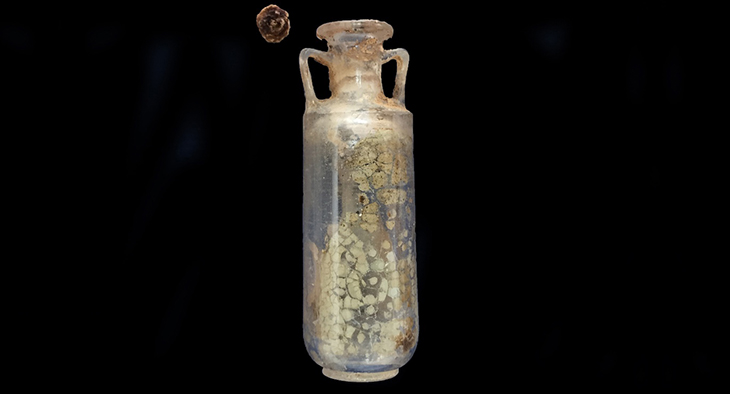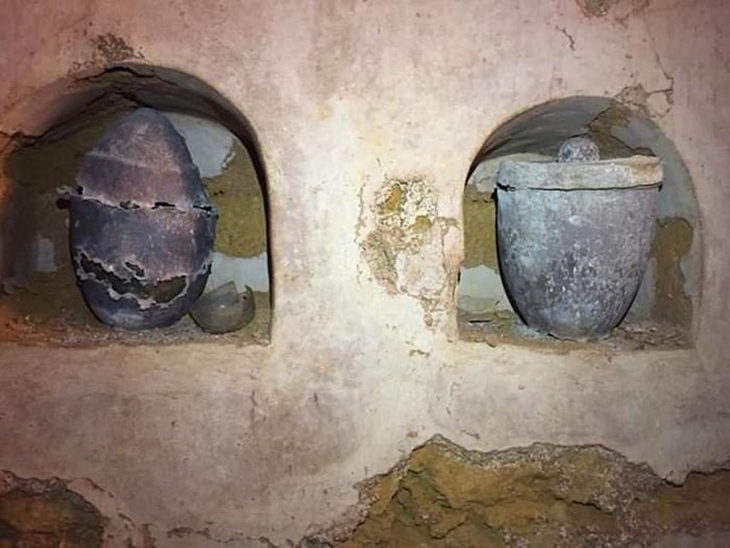
In a remarkable archaeological discovery, a sealed vial of Roman perfume dating back 2,000 years has been unearthed, offering a rare glimpse into the ancient world of fragrances.
The small glass container, made from dolomite – a type of carbon – was found intact within a funerary urn in the Roman city of Carmo, which is now the modern-day Carmona found near Seville, Spain. It astounded researchers with its incredible preservation, allowing them to delve into the scents of antiquity.
The discovery came to light during an archaeological excavation at a mausoleum found during the construction of a house on Calle Sevilla. This collective tomb, believed to belong to a wealthy family, contained the cremated remains of six adults, three women, and three men, along with various objects associated with funeral rituals. In one of the urns made of glass lay the cremated skeletal remains of a woman between 30 and 40 years old, alongside a cloth bag. Inside the bag they found three amber beads and a small quartz flask that was crafted in the shape of an amphora, holding the well-preserved ointment.

Another amazing aspect of their find was that, twenty centuries later, the vial was still perfectly sealed. Moreover, the solid residues of the perfume had been preserved inside, making it possible for researchers to test every component of the items they found.
Led by Professor José Rafael Ruiz Arrebola, an expert in Organic Chemistry at the University of Cordoba, a team of researchers analyzed the ancient perfume sample using advanced techniques such as X-ray diffraction and gas chromatography coupled with mass spectrometry.
This scientific investigation yielded invaluable insights into the perfume’s composition, and the results were published in the journal Heritage.
The study revealed that the perfume’s base or binder, responsible for preserving its aromatic qualities, was a type of vegetable oil, possibly derived from olives, as suggested by certain indications in the analysis The essence itself was identified as patchouli, an essential oil originating from a plant of Indian origin. Modern perfumery also utilizes patchouli, making this discovery a significant breakthrough in understanding Roman perfumery practices.
Professor Arrebola said, “To our knowledge, this is possibly the first time a perfume from Roman times has been identified.”
“This is the first report on the use of bitumen as a sealing agent in an unguentarium with a dolomite stopper—another unique finding.”
The precious nature of the vessel housing the perfume, along with the tomb’s monumental characteristics, suggests that this scented treasure held considerable value in ancient Roman society. Its inclusion in the burial rites of a respected woman further underscores the significance and social status associated with fragrances during that time.
This remarkable discovery not only allows us to recreate an ancient scent but also offers a window into the sophisticated craftsmanship and cultural practices of the Roman civilization. The careful preservation of the perfume over two millennia demonstrates the remarkable ingenuity of ancient artisans and the reverence with which they treated death and the afterlife.
The findings of this study add to our knowledge of Roman material culture and further enrich our understanding of the intricate aromas that graced the ancient world. By unraveling the secrets of this ancient perfume, researchers continue to bridge the gap between the past and present, shedding light on the timeless human fascination with scents and their connection to rituals and cultural expressions.
What are your thoughts? Please comment below and share this news!
True Activist / Report a typo


